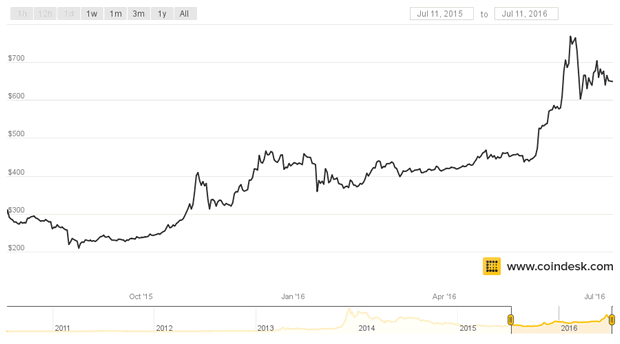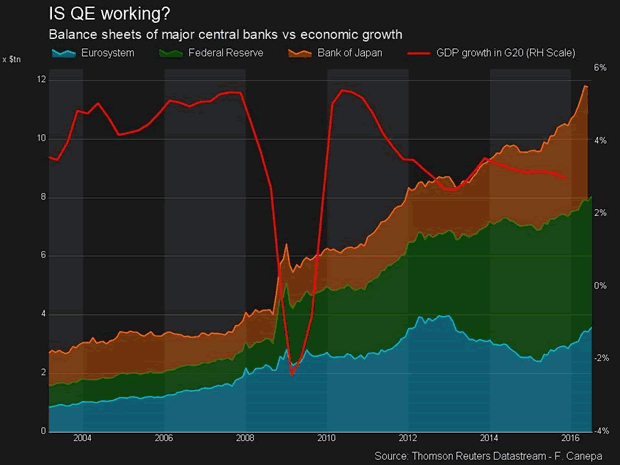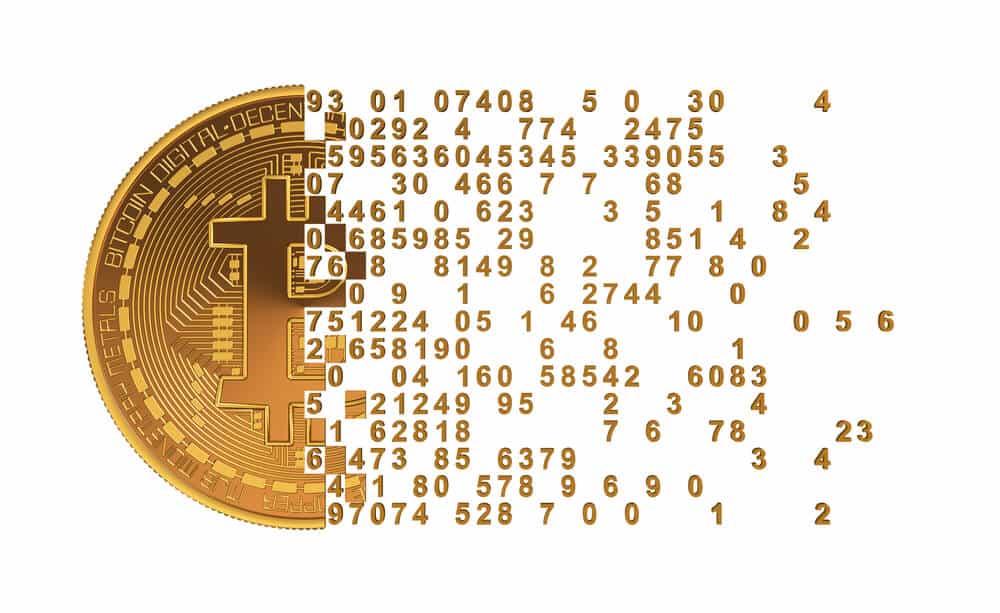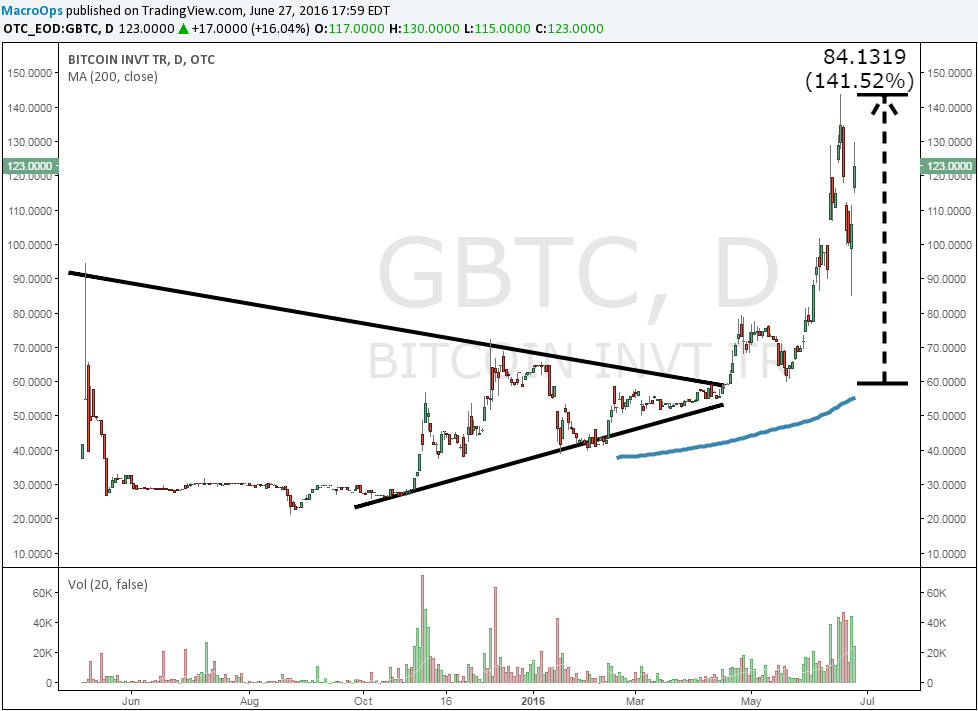Currency
 Summary
Summary
Our bullish dollar outlook was based on divergence and we judge it to still be intact.
The Dollar Index has been trading broadly sideways since March 2015, but never did more than a minimum retacement of its earlier rally.
The Dollar index is at it highest level since March today.
related:
On Bitcoin: A New Asset Class Worth Owning
‘Bitcoin’ is on a tear away rally. Its’ performance, over the last year, has been outstanding and it has outperformed most ‘asset classes’, by a wide margin. It is probably the only asset class which beats out both gold and silver, in 2016. Why is it shooting into outer space?

People look at alternate asset classes when their confidence in traditional assets fades. Since the beginning of the year, both the stock and the commodity markets have been on a roller coaster ride while catching both the bulls and the bears, on the wrong side.
The macroeconomic situation of the world does not give confidence to the astute investors which is evident by the return of the legendary George Soros, who has come out of retirement to short the overblown markets. Similarly, other hedge fund managers are stocking up on gold, which supports our view that a ‘financial crisis’ is right around the corner.
The “Brexit” results have also opened up a possibility of another round of easing by the central banks, around the world. The Bank of England will most likely resort to an easing schedule during the next meeting which will be followed by the European Central Bank and the FED. Post victory in the elections, the Japanese Prime Minister Shinzo Abe is likely to push the Bank of Japan to announce another round of ‘easing’.
Since the last ‘financial crisis’, the combined central banks have pumped massive amounts of money into the system and they continue to do so, at a rapid pace, nonetheless, the world is closer to a ‘financial crisis’ than ever before.

The FED’s money printing policy had led the commodity Guru Jim Rogers to remark: “The FED will continue to print money until there are no trees left in America.”
‘Bitcoin’ is doing the opposite of central banks:
Compare this with the cryptocurrency ‘bitcoin’. Unlike the traditional currencies, the ‘Bitcoin’ has an upper limit of 21 million coins, post which no more Bitcoins can be mined.
Every subsequent mining will become difficult and will reduce the reward associated with mining each block. Satoshi Nakamoto programmed that post-mining of 210,000 blocks, the rewards will be halved.
Initially, the reward was 50 ‘Bitcoins’ for every block, which was halved by the end of 2012, at which time the reward was reduced to 25 ‘Bitcoins’ per block.
The next round of halving took place, last week, when the rewards were reduced to 12.5 ‘Bitcoins’ per block.
While the central banks have been on a printing spree, the ‘Bitcoin’ is on a tightening route which boosts its’ price, as is visible in its’ sharp rise, this year.
A few miners will find it difficult to continue mining at the halved rewards which is likely to slow down new mining as halving will continue, in the future.
“The block halving will dramatically decrease the bitcoin being added as we approach 75 percent of all bitcoin issued. People understand that in this world of ever expanding assets and printing of money, we have something that’s fixed and limited in issuance. It gives a decent alternative for people who want to hold assets that can have sustained purchasing power,” stated Bobby Lee, Chief Executive of BTCC which is one of the largest’ bitcoin’ exchanges, in the world, based in China reports CNBC.
I recently watch a fantastic TEDX talk on Bitcoin and digital currencies and how they are changing the world, financial systems, and lives in huge way, and this is only the tip of the iceberg. This TEDX Talk makes so much logical sense why bitcoin and other currencies are so important for us as individual’s – Watch Video
In fact, I have been researching the digital wallet solution where I can purchase many up and coming digital currencies within one location as a NEW ASSET class for my portfolio. Why? Because I firmly believe the masses will slowly migrate their money into various digital currencies a safe haven store of wealth and for ease of use. Payments can be made with your mobile phone to anyone, anywhere in the world and for any amount with ZERO fees/costs, and in many cases it cannot be traced.
Sir John Templeton, the legendary mutual fund manager and founder of Templeton Group, said:
“Invest in many different places – there is safety in numbers.”
So in short, I will share with you in future articles and as a subscriber to my trading and investing newsletter exactly which digital wallet, and digital currencies I will be buying and interested in learning more about as the world and financial systems evolve. When the time is right to invest my followers will know.
also:
Michael Campbell’s Live From The Trading Desk – Key Reversals
 The dollar rose to a one-week high against the yen on Monday, climbing almost 2%, following Japanese Prime Minister Shinzo Abe’s call for a fresh round of fiscal stimulus after a victory for his ruling coalition in local elections.
The dollar rose to a one-week high against the yen on Monday, climbing almost 2%, following Japanese Prime Minister Shinzo Abe’s call for a fresh round of fiscal stimulus after a victory for his ruling coalition in local elections.
News that the stimulus could reach 10 trillion yen ($97.5 billion) helped Japan’s stock market jump 4% and sent the dollar soaring against the Japanese currency. The Bank of Japan is expected to provide additional easing to keep interest rates low and the yen weak to make sure stimulus spending can gain traction.
“It now looks like there’s coordinated fiscal and monetary policy,” said Greg Anderson, global head of foreign exchange strategy at BMO Capital Markets in New York. “If you get a fiscal policy that is expansive…the natural thing is to finance that with money-printing.”
Investors had been buying the yen through much of this year as the Bank of Japan chose to hold off on currency intervention. Abe has promised to revive the economy with hyper-easy monetary policy, fiscal spending and reforms, a collective program known as “Abenonics.”
“It looked like part of what held the Bank of Japan back several times earlier this year is it just didn’t make sense to expand (quantitative easing) if there’s no coordination with fiscal policy,” Anderson said. “But now there is.”
The dollar rose as much as 2.1% to a high of 102.66 yen, on pace for its biggest one-day gain since April. It was last up 1.9% at 102.48 yen.
The greenback fell as low as 99 yen on June 24 in the aftermath of Britain’s decision to leave the European Union, which drove investors to the Japanese currency and other safe havens.
The dollar hit a four-month high of 96.793 against a basket of major currencies, having already received a lift by a U.S. jobs report that outpaced even the loftiest expectations on Friday. The report pushed investors to price back in the chance of an increase in interest rates by the Federal Reserve before the end of the year.
The dollar index was last up 0.2% at 96.501.
Sterling reversed earlier losses to turn positive on the day after Theresa May emerged as the only remaining candidate to lead Britain’s ruling Conservative Party and become prime minister following rival Andrea Leadsom’s exit from the race.
These are dangerous markets!
“A lot of the price run-ups in these virtual currencies have been due to investors’ beliefs in utopian fantasies of perfect financial systems without regulations. When beliefs stretch that far out into left field, any small trip up in the investment narrative (such as a system hack) will cause prices to come tumbling down.
This is why we’ve seen multiple large crashes in these cryptocurrencies in just the few years of their existence. These are dangerous markets and investors should be wary of getting involved.”
related:
An Everyman’s Guide To Understanding Cryptocurrencies

When an asset rises by almost 30% in a few weeks, it tends to attract attention. Recently, that asset was bitcoin (BTC). The price of BTC in dollars rose from $454 on May 23 to $590 on June 6th.
When an asset doubles in a matter of a few months, it tends to attract attention. The cryptocurrency Ether (part of the Ethereum platform) doubled from around $7 in April to roughly $14 in early June.
Are these cryptocurrencies mere fads? Or are they potentially game-changing alternatives to the conventional currencies such as the U.S. dollar, Chinese RMB, Japanese yen or European Union euro?
Cryptocurrencies are digital currencies that are not issued by governments
…read more including The Role of Cryptocurrencies in Capital Preservation
also:
Along with the boom in crypto-currencies be sure to read Jack Crooks: Abandon Ship – Brexit implications
















